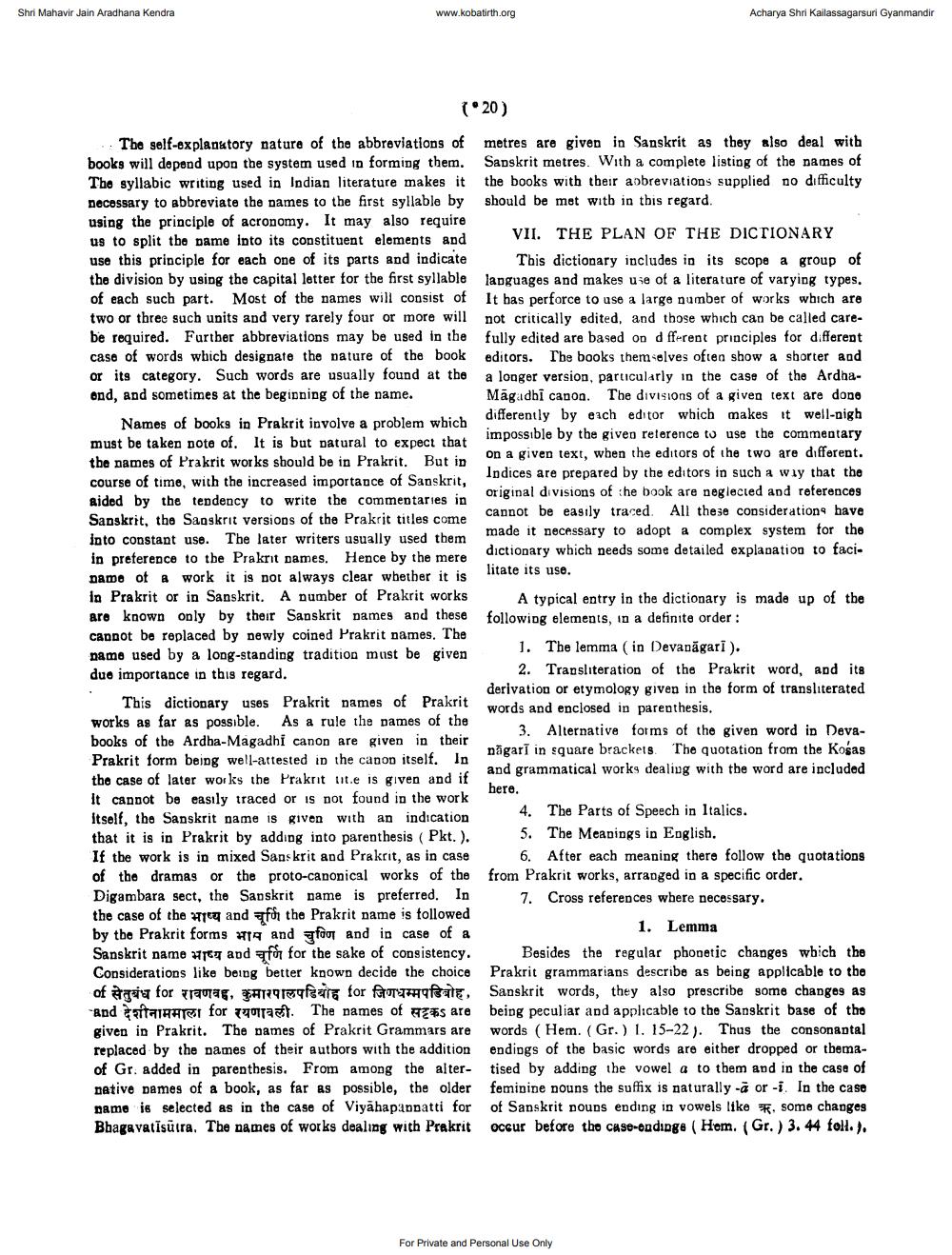________________
Shri Mahavir Jain Aradhana Kendra
www.kobatirth.org
Acharya Shri Kailassagarsuri Gyanmandir
(20)
. The self-explanatory nature of the abbreviations of metres are given in Sanskrit as they also deal with books will depend upon the system used in forming them. Sapskrit metres. With a complete listing of the names of The syllabic writing used in Indian literature makes it the books with their aobreviations supplied no difficulty necessary to abbreviate the names to the first syllable by should be met with in this regard. using the principle of acronomy. It may also require us to split the same into its constituent elements and
VII. THE PLAN OF THE DICTIONARY use this principle for each one of its parts and indicate This dictionary includes in its scope a group of the division by using the capital letter for the first syllable languages and makes use of a literature of varying types. of each such part. Most of the names will consist of It has perforce to use a large number of works which are two or three such units and very rarely four or more will not critically edited, and those which can be called carebe required. Further abbreviations may be used in the fully edited are based on d fferent principles for different case of words which designate the nature of the book editors. The books themselves often show a shorter and or its category. Such words are usually found at the a longer version, particularly in the case of the Ardhaond, and sometimes at the beginning of the name.
Magadhi canon. The divisions of a given text are dono Names of books in Prakrit involve a problem which
differently by each editor which makes it well-nigh must be taken note of. It is but natural to expect that
impossible by the given reference to use the commentary the names of Prakrit works should be in Prakrit. But in
on a given text, when the editors of the two are different. course of time, with the increased importance of Sanskrit,
Indices are prepared by the editors in such a way that the
original divisions of the book are neglected and references Rided by the tendency to write the commentaries in Sanskrit, the Sanskrit versions of the Prakrit titles come
cannot be easily traced. All these considerations have into constant use. The later writers usually used them
made it necessary to adopt a complex system for the in preterence to the Prakrit Dames. Hence by the mere
dictionary which needs some detailed explanation to facinamo of a work it is not always clear whether it is
litate its use. in Prakrit or in Sanskrit. A number of Prakrit works A typical entry in the dictionary is made up of the are known only by their Sanskrit names and these following elements, in a definite order: cannot be replaced by newly coined Prakrit names. The
| ]. The lemma (in Devanāgari ). name used by a long-standing tradition must be given duo importance in this regard.
2. Transliteration of the Prakrit word, and its
derivation or etymology given in the form of transliterated This dictionary uses Prakrit names of Prakrit
words and enclosed in parenthesis. works as far as possible. As a rule the pames of the
3. Alternative forms of the given word in Devabooks of the Ardba-Magadhi canon are given in their
năgarī in square brackets. The quotation from the Kosas Prakrit form being well-attested in the canon itself. In
and grammatical works dealing with the word are included the case of later works the Prakrit lite is given and if
here. It cannot be easily traced or is not found in the work Itself, the Sanskrit name is given with an indication
4. The Parts of Speech in Italics. that it is in Prakrit by adding into parenthesis (Pkt.).
5. The Meanings in English. If the work is in mixed Sanskrit and Prakrit, as in case 6. After each meaning there follow the quotations of the dramas or the proto-canonical works of the from Prakrit works, arranged in a specific order. Digambara sect, the Sanskrit name is preferred. In 7. Cross references where necessary. the case of the 19 and of the Prakrit name is tollowed by tbo Prakrit forms 9 and foot and in case of a
1. Lemma Sanskrit name ty and Tfór for the sake of consistency. Besides the regular phonetic changes which the Considerations like being better known decide the choice Prakrit grammarians describe as being applicable to the of सेतुबंध for रावणवह, कुमारपालपडिबाह for जिणधम्मपडिबोह, Sanskrit words, they also prescribe some changes as "and देशीनाममाला for रयणावली. The names of सहकs are being peculiar and applicable to the Sanskrit base of the given in Prakrit. The pames of Prakrit Grammars are words (Hem. (Gr.) 1. 15-22). Thus the consonantal replaced by the names of their authors with the addition endings of the basic words are either dropped or themaof Gr. added in parenthesis. From among the alter- tised by adding the vowel a to them and in the case of native names of a book, as far as possible, the older feminine nouns the suffix is naturally -ä or -1. In the case Dame is selected as in the case of Viyahapannatti for of Sanskrit pouds ending in vowels like , some changes Bhagavatīsūtra. The names of works dealing with Prakrit occur before the case-ondinge (Hom. (Gr.) 3. 44 foll. ).
For Private and Personal Use Only




